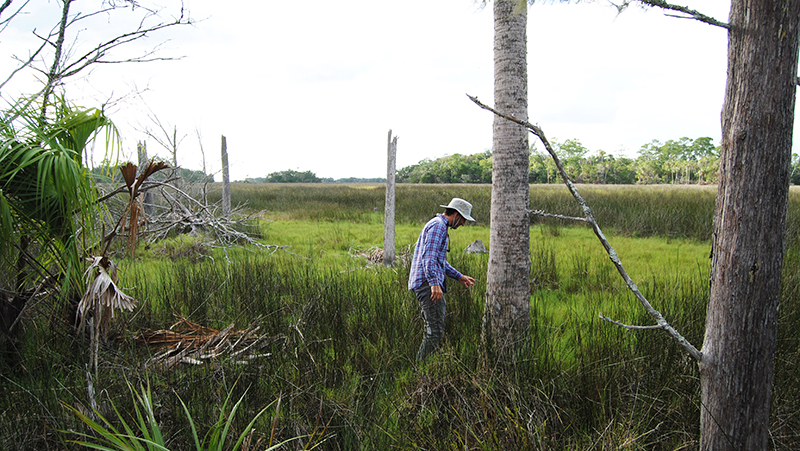
A steady increase in sea levels is pushing saltwater into U.S. wetlands, killing trees from Florida to as far north as New Jersey. But with sea level projected to rise by as much as six feet this century, the destruction of coastal forests is expected to become a worsening problem worldwide.
On a recent afternoon, University of Florida watershed ecologist David Kaplan and Ph.D. candidate Katie Glodzik hiked through the Withlacoochee Gulf Preserve, on the Big Bend coast of northwestern Florida. Not long ago, red cedar, live oaks, and cabbage palms grew in profusion on the raised “hammock island” forests set amid the preserve’s wetlands. But as the researchers walked through thigh-high marsh grass, the barren trunks of dead cedars were silhouetted against passing clouds. Dead snag cabbage palms stood like toothpicks snapped at the top. Other trees and shrubs, such as wax myrtle, had long been replaced by more salt-tolerant black needlerush marsh grass.
Saltwater, flowing into this swampy, freshwater-dependent ecosystem as a result of rising sea levels, is turning these stands of hardwoods into “ghost forests” of dead and dying trees.
“The loss of these islands changes the landscape from a mosaic to one dominated by a single habitat — salt marsh,” said Kaplan, noting that the change means reduced habitat for some species of wading and migratory birds, as well as for turtles and snakes.
A similar transformation is occurring in coastal floodplains across the southeastern and mid-Atlantic regions of the United States, representing what scientists say is the leading edge of climate change in what were once largely freshwater ecosystems. From Florida’s hammock islands to North Carolina’s swamp forests, rising sea levels, often compounded by regional water management practices, continue to push saline water further inland, wiping out swampy woodlands.
“Ghost forests are a dramatic expression of climate change,” says Gregory Noe, a research ecologist with the U.S. Geological Survey who has been studying the impacts of dying cypress in the iconic swamps along the Savannah River, which forms much of the border between Georgia and South Carolina.
read more/source: http://e360.yale.edu/feature/ghost_forest_rising_sea_levels_killing_coastal_woodlands/3049/
